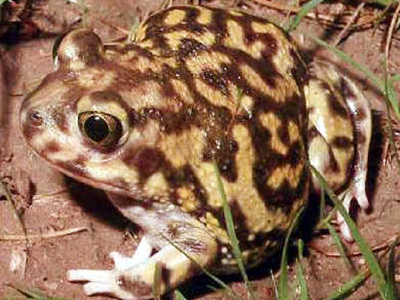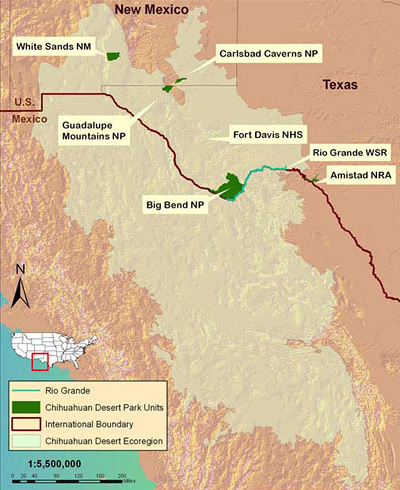The Chihuahuan Desert supports more than 170 herpetofauna (reptile and amphibian) species, and the Chihuahuan Desert Ecoregion (a larger area not strictly defined by the desert itself) supports approximately 217 native species (Fitzgerald et al. 2004).

Colorado Parks & Wildlife
Some animals that are typical of the Chihuahuan Desert (but which may also occur outside of the area) include the Mohave rattlesnake (Crotalus scutulatus), coachwhip (Masticophis flagellum), New Mexico whiptail (Aspidocelis neomexicana), red-spotted toad (Bufo punctatus), and Trans-Pecos ratsnake (Bogertophis subocularis). At least 18 reptile species are endemic to the Chihuahuan Desert, but there are no endemic amphibian species. The ranges of several lizards are centered in the Chihuahuan Desert, including the Texas banded gecko (Coleonyx brevis), Texas horned lizard (Phrynosoma cornutum), greater earless lizard (Cophosaurus texanus), Western marbled whiptail (Aspidoscelis marmorata marmorata), and several species of spiny lizards (Sceloporus spp.).
Amphibians and reptiles are important components of aquatic and terrestrial ecosystems. Amphibians constitute an important part of the food web; they consume insects and other invertebrates, and they are prey for a long list of fish, reptile, bird, and mammal species, and even some predatory aquatic insects. Reptiles too serve as both predators and prey for many animals, such as small mammals, birds, and other reptiles. The occurrence of amphibians is associated with healthy wetland habitats. Amphibians serve as indicators of ecosystem health because their permeable skin and complex life histories make them particularly sensitive to environmental disturbance and change. Reptiles and amphibians are also of aesthetic value to visitors of the national park units within the CHDN.
Amphibians and reptiles are, together, referred to as herpetofauna or “herps.” Most herpetofauna species lay eggs, although some give birth to live young. They are ectotherms, meaning they are unable to regulate heat within their own bodies and warm up or cool off through behavioral means (e.g., basking or seeking shade). Although this places limits on their distribution and times of activity, it allows them to live on less energy than mammals or birds of similar size. Amphibian and reptile species may occupy similar habitats and are similarly vulnerable to habitat degradation and other threats. Herpetofauna populations may exhibit dramatic, natural fluctuations in site occupancy, distribution, abundance, and species richness.
Distribution & Life History

The location of the parks in the CHDN and the extent of the Chihuahuan Desert in both the U.S. and Mexico are shown in Figure 1. Not only are there a large number of herpetofauna species in the CHDN, there are a number of resources that describe their distribution and life history. Thus, rather than duplicating such material here, we refer readers to some of the alternative sources (see the last section of the overview, “Sources of Distribution and Life History Information”). It is not our intent to endorse any particular source, but to provide a sampling of what is available. Additionally, recent herpetofauna surveys have been conducted in the parks of the CHDN; the results of these inventories are discussed in the “Management and Monitoring Activities” section of the overview. Lists of federally threatened and endangered species at individual parks can be obtained online from the NPSpecies Database.
Part of a series of articles titled Amphibians and Reptiles in the Chihuahuan Desert.
Next: Ecology
Last updated: February 23, 2017
